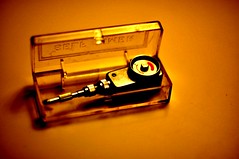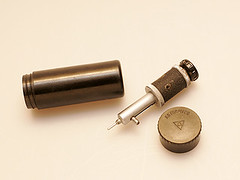Difference between revisions of "Self-timer"
m |
(Noted the alternative term 'dleayed action'; noted common 2- or 10-second choice; e.g. Canon A-1.) |
||
| Line 1: | Line 1: | ||
{{glossary}} | {{glossary}} | ||
| − | A '''self-timer''' is a mechanism which is used to trigger the shutter after a set period of time - allowing the photographer to be in the picture, or to avoid vibrations introduced by fingers. This mechanism is either built into the [[shutter release]] of a camera or used as an add-on accessory. | + | A '''self-timer''' is a mechanism which is used to trigger the shutter after a set period of time - allowing the photographer to be in the picture, or to avoid vibrations introduced by fingers. This mechanism is either built into the [[shutter release]] of a camera or used as an add-on accessory. Instructions for aome older cameras may refer to this as a '''delayed-action''' mechanism. |
Older mechanical self-timers, such as those on old [[Leica]]s or sold as accessory, typically employed some sort of a resistance coil. The user would pre-wind the coil to load it with tension, and then it would unwind. When it finished unwinding it would trip the shutter release. | Older mechanical self-timers, such as those on old [[Leica]]s or sold as accessory, typically employed some sort of a resistance coil. The user would pre-wind the coil to load it with tension, and then it would unwind. When it finished unwinding it would trip the shutter release. | ||
Accessory self-timers can be used by screwing into the [[shutter release]] button; and most have the ability to adjust the trip mechanism length to match the specific camera. A special type are self timers that can be used for the [[cable release]] instead of the shutter release button. | Accessory self-timers can be used by screwing into the [[shutter release]] button; and most have the ability to adjust the trip mechanism length to match the specific camera. A special type are self timers that can be used for the [[cable release]] instead of the shutter release button. | ||
| − | Modern electronic cameras use digital timers. Most digital timers have a set time (eg, 10 seconds) which counts down, giving beeps or flashing [[LED]]s as warnings, and then trips the shutter. Some electronic cameras offer the ability to | + | Modern electronic cameras use digital timers. Most digital timers have a set time (eg, 10 seconds) which counts down, giving beeps or flashing [[LED]]s as warnings, and then trips the shutter. Some electronic cameras offer the ability to vary the delay time. The [[Canon A-1]] can be set to delay exposure by 2 seconds (to allow vibrations to finish) or 10 seconds, for the photographer to be in the picture (forty years later, the EOS M50 still offers the same choice of delay times). |
{|class=plainlinks | {|class=plainlinks | ||
Revision as of 18:47, 23 July 2021
A self-timer is a mechanism which is used to trigger the shutter after a set period of time - allowing the photographer to be in the picture, or to avoid vibrations introduced by fingers. This mechanism is either built into the shutter release of a camera or used as an add-on accessory. Instructions for aome older cameras may refer to this as a delayed-action mechanism.
Older mechanical self-timers, such as those on old Leicas or sold as accessory, typically employed some sort of a resistance coil. The user would pre-wind the coil to load it with tension, and then it would unwind. When it finished unwinding it would trip the shutter release. Accessory self-timers can be used by screwing into the shutter release button; and most have the ability to adjust the trip mechanism length to match the specific camera. A special type are self timers that can be used for the cable release instead of the shutter release button.
Modern electronic cameras use digital timers. Most digital timers have a set time (eg, 10 seconds) which counts down, giving beeps or flashing LEDs as warnings, and then trips the shutter. Some electronic cameras offer the ability to vary the delay time. The Canon A-1 can be set to delay exposure by 2 seconds (to allow vibrations to finish) or 10 seconds, for the photographer to be in the picture (forty years later, the EOS M50 still offers the same choice of delay times).

|

|

|
| accessory self-timer by scenery_and_fish (Image rights) |
pneumatic accessory self-timer by Siim Vahur (Image rights) |
electronic self-timer by David Johnson (Image rights) |

|
| Instructions for use Yashica Mechanical Self Timer image by Pablo Coronel (Image rights) |